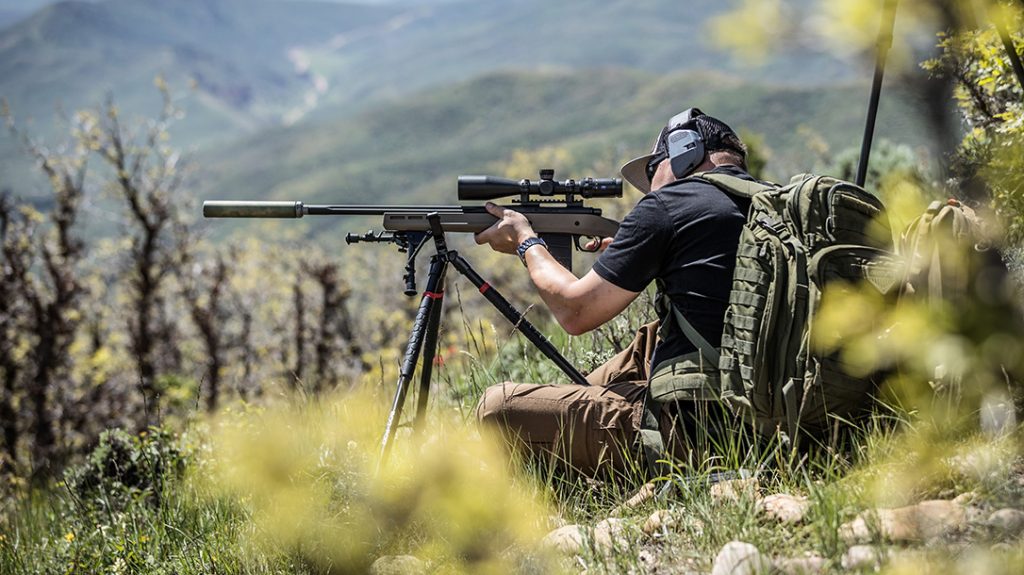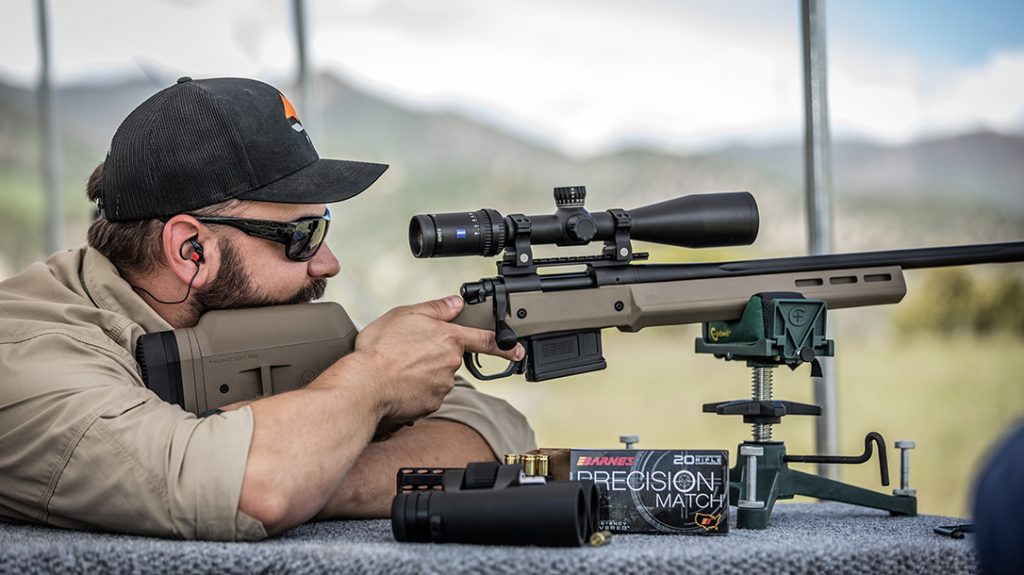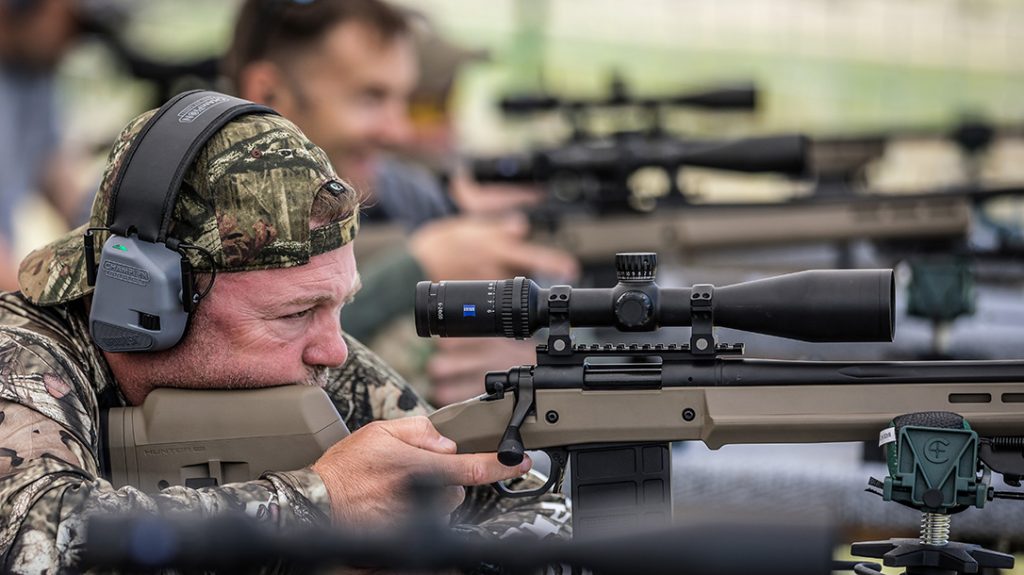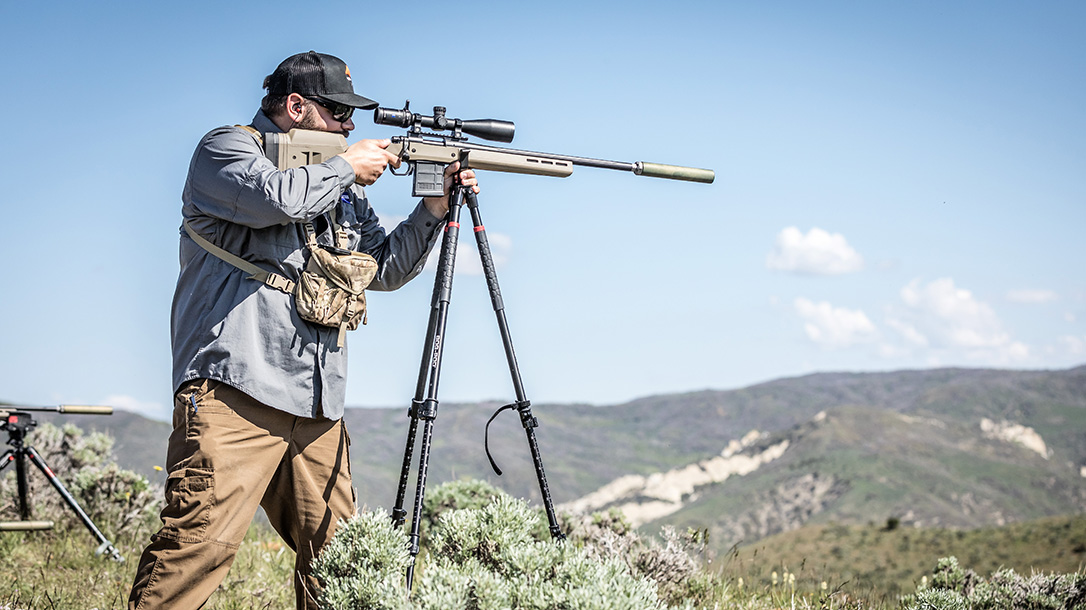Imagine being an experienced hunter intimately familiar with conditions in the Appalachian Mountains or Carolina swamplands, where 300-yard shots are considered long. Now you have an opportunity to hunt in Montana, where distances can be much greater. They don’t call it Big Sky Country for nothing. No matter how many deer or other animals you’ve harvested, a Rocky Mountain elk or Texas whitetail will most likely surpass all prior experiences in terms of engagement distances. The Outdoor Solutions Long Range Shooting Schools in Utah, Texas and Michigan cater to hunters for just this situation.
Outdoor Solutions Long-Range Hunter Training
Working in the hunting and fishing destination industry since 2003, the Outdoor Solutions team understands what it takes to put together successful adventures. For example, any destination booked via Outdoor Solutions has been thoroughly vetted by its team. But the company isn’t just out to create a bursting catalog of outfitters. Outdoor Solutions is looking for guides who have stood the test of time and successfully take care of their clients.
Greg Ray, the founder and co-owner of Outdoor Solutions, quickly realized that another service could benefit his clients: honing long-range shooting skills. Guided hunts aren’t inexpensive when it comes to money or time. Some adventures are once-in-a-lifetime affairs. Why not invest in training to increase your skills and set realistic limitations before the adrenaline dump hits when a trophy steps out two ridges over?
Advertisement — Continue Reading Below
Going Long
Anyone savvy enough to reach out to Outdoor Solutions for training has a great advantage over other hunters. It’s surprising how many hunters neither seek out nor appreciate the benefits of receiving professional guidance from experts. Arrogance may seem like a strong word, but just because you’ve been shooting since you could walk (I’m speaking tongue in cheek here) doesn’t mean you are as proficient as you imagine or that you won’t benefit from further training.

I jumped at the chance to attend the inaugural Outdoor Solutions long-range shooting course held near Coalville, Utah. Customer get to hone their skills in a setting that resembles what they will encounter on future hunts. You aren’t on a sterile, flat range surrounded by other bays or squads hammering away at targets. The experience in Utah was worth it in terms of the scenery alone, and the accommodations were top-notch.
Advertisement — Continue Reading Below
The initial orientation took place the evening I arrived. It was quickly stressed that the goal was not to encourage unethical practices, such as firing at game animals at extreme distances. In fact, the exact opposite is in play. Under the observation of the highly trained Outdoor Solutions staff, any misperceptions of skill level are quickly dispelled. Both Erik Lund and Ryan Long are trained law enforcement and military marksmen with downrange experience in hostile theaters. Better yet, both are active sportsmen, which gives them valuable insights about what hunters encounter in the field. The primary goal of the Outdoor Solutions course is to take shooters beyond their preconceived notions and give them a solid, proven skill set to draw upon.
No Shortcuts
A word about gear is necessary. Your rifle, optic and ammunition must all be scrutinized, or you’ll be chasing your tail when distances go beyond 400 yards. Outdoor Solutions has created solid relationships with ideal industry partners, including Remington, Barnes, Advanced Armament and Zeiss, which provide the essentials for the Utah experience. That said, the company maintains and proves that an out-of-the-box rifle can generate the requisite accuracy needed for long-range hunting. We used Remington Model 700 5-R Gen 2 and Model 700 Magpul Enhanced rifles in 6.5 Creedmoor and 6mm Creedmoor, respectively, for the course, and both proved perfectly capable of 1-MOA accuracy well beyond 100 yards. We fired hundreds of shots out to 1,000 yards under the supervision of Outdoor Solutions instructors and shooting partners, who rotated between roles as spotters and shooters.
Of course, accuracy isn’t produced in a vacuum. Ammunition and optics are equal parts of the equation. We used Barnes ammo, and the Remington rifles were equipped with 6-24x50mm Zeiss Conquest V4 scopes with ZBR-1 reticles. We also used Zeiss Victory RF laser rangefinding binoculars—combining Bluetooth connectivity with the Zeiss Hunting app—to bring state-of-the-art technology to hunting.
Advertisement — Continue Reading Below
Building Skills
Equipment is great, but it’ll never trump skill. Outdoor Solutions believes in proven gear that assists in making accurate hits at a distance—not gimmicks and overreliance on too much tech. The shooter is the key in bringing together the triumvirate of rifle, ammunition and optic. Frankly, the shooter is oftentimes the weak link. Outdoor Solutions strives to strengthen the shooter’s proficiency with the goal of producing successful hunts.

The first day of the course took place on a known-distance range with steel targets at every 100 yards, stretching out to 1,000 yards. Instructors worked on the basic building blocks of positions and trigger prep while trainees fired from the bench. They also made the point that your rifle is never as stable as when it’s resting on its own, with no shooter input. The goal is to minimize shooter input and energy, but of course this depends on the firing position and situation.
Advertisement — Continue Reading Below
Putting it all Together
Day one at the range turned us loose to put what we had talked about into practice. There is no better way to inculcate concepts than with hands-on application. Shooters were paired up into two-person squads, with shooting and spotting duties rotated. The Conquest Gavia spotting scopes reinforced Zeiss’ world-class reputation for producing some of the best glass in the industry. The Zeiss Victory RF binos, combined with the Zeiss Hunting app, provided holdover information using the Zeiss ZBR-1 reticle. However, the instructors preferred to dial in the correct MOA values via the turrets.
The true art of long-range accuracy is correctly reading the wind in terms of direction and speed. This is where the Outdoor Solutions system of pairing students as spotters and shooters is so beneficial. You get double the time reading wind and observing its effects. Sitting behind a spotting scope, especially one of Zeiss quality, gives a student a front-row seat to see how wind affects a bullet’s flight.
KD Range Kickoff
Starting at the known-distance range gives students time to familiarize themselves with equipment and procedures. This also allows instructors to evaluate a student’s existing skillset in a controlled environment. For example, I learned to keep the trigger pulled to the rear until I observed an impact. (I must have been shooting too many pistols, as I was resetting the trigger upon firing.) This sounds simple, but it made a real improvement in my long-range consistency.
Advertisement — Continue Reading Below
Even with target arrays clearly marked, students went through range-finding procedures with Zeiss binoculars, consulted with the Zeiss Hunting app and dialed adjustments into their Zeiss scopes. Spotters were responsible for wind calls. Fortunately, the wind was relatively moderate the first day, with gusts between 10 and 20 mph. We communicated all wind call adjustments in minutes of angle (MOA), with mil and inch terminology avoided. Roughly speaking, 1 MOA equals 1 inch every 100 yards downrange. For example, at 100 yards, 1 MOA is approximately 1 inch. At 400 yards, 1 MOA equals 4 inches, and so on. It’s also worth noting that the Zeiss scope turrets were set up for 0.25-inch MOA adjustments.

After establishing 100-yard zeroes and shooting groups out to 300 yards, none of us had any doubts about our Remington rifles, Zeiss scopes or Barnes ammo. In other words, we couldn’t blame our gear for misses. Numerous drills between 300 and 1,000 yards, with stops in between at various ranges, established solid communication between shooters and spotters, who dialed in corrections for range and wind.
Advertisement — Continue Reading Below
Making The Grade
The meat of the Outdoor Solutions course centers around day two. This time there was no comfy shooting from a bench at large steel targets at known distances. We moved up into the Utah mountains, with steel targets on opposing hillsides anywhere from 150 to 1,100 yards away. Upward and downward angles introduced further complications. We couldn’t always go prone, especially during a hunting situation.
Each engagement station had an Outdoor Solutions instructor present to offer guidance about how best to build a stable shooting position from an assortment of Bog tripods, bipods, shooting sticks and Sand Sock bags. Instructors let each squad try their hand initially, and then made their suggestions. It was eye-opening how stable you could make a sitting position with a few lightweight Sand Sock shooting bags, a backpack and Bog shooting sticks. We also tried Bog tripods with a Sand Sock shooting bag under one arm.
Dialing In
The Zeiss binos and Hunting app proved crucial in producing first-round hits on the reduced-size steel targets. Wind became more of an issue as well, with Mother Nature ramping it up. The varied terrain produced wind shears and swirls that our rounds had to pass through.
Advertisement — Continue Reading Below
While your skills might be enhanced during the two days of training, more importantly, you’ll learn more about your limitations. It’s better to learn your limitations at the Outdoor Solutions course than out in the field, where losing a wounded animal is far worse than merely dropping a point during a competition. Long-range shooting is a learned skill that perishes without constant practice. Why not get a crash course before embarking on the hunt of a lifetime? Outdoor Solutions has placed itself perfectly to assist with both booking a hunt and making sure you are as successful as possible. For more information, visit outdoorsolutionscorp.com.
This article is from the December 2019 issue of Tactical Life magazine. Grab your copy at OutdoorGroupStore.com. To watch exclusive footage from the event, please visit BallisticMag.com.
























